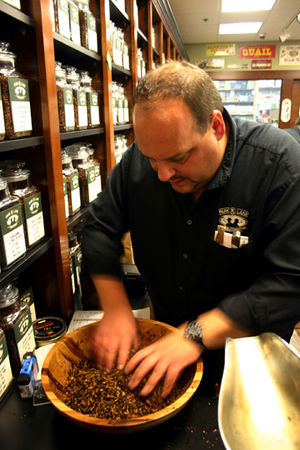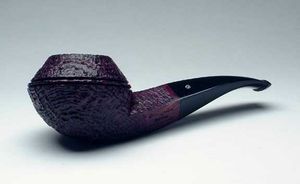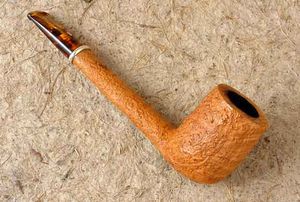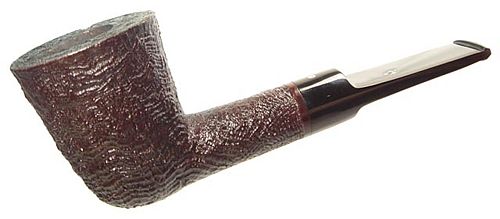Bonaquisti
Paul's website
The following article originally appeared in The Pipe Collector, the official publication of the North American Society of Pipe Collectors (NASPC), and is used by permission. It's a great organization--consider joining.
Paul Bonaquisti began his involvement with wood at an early age. He was born and raised in North Greenbush, NY, a small town outside Albany, where his family was involved in a retail lumber yard with a large cabinet shop and later with a general construction business. Growing up in this environment was an exciting time for Paul, and during those early years, he would hang around his father's shop waiting for the day he would be old enough to strap on a tool belt and join "the crew."

He eventually got that opportunity and served his apprenticeship under his father's guidance. His father, a talented carpenter and cabinet maker, is the one person Paul credits with getting him really interested in the woodworking field and wood turning in particular. He worked with his father and brothers all through his teens and full time for a few years after high school. Wanting to continue his education in a related field, Paul enrolled in a construction program at a local college, where he was later awarded a scholarship to continue his education in the architectural field. He eventually returned to the family business and worked there until 1984, when, with his brother John, he decided to start his own business a commercial woodworking shop that they continue to operate to this day.


The carpenters and cabinet makers under whom Paul served his apprenticeship were talented craftsmen who took their work very seriously. Paul learned from them not only basic woodworking skills but, more importantly, a real love for the work and the knowledge that a talented craftsman needs more than just his tools to bring a concept to life. He must also possess a certain way of thinking and problem solving. Paul feels that this way of thinking, to never walk away from a project until you are personally satisfied with it, is a concept often lost in today's "good enough" mentality.
Paul started smoking a pipe in high school when he "borrowed" one of his father's pipes and some tobacco. When he started earning some money, he bought his first pipe, a metal one with interchangeable bowls like a Falcon or Kirsten. After experimenting with different pipes, Paul eventually moved on to briar pipes, which he had been told were the best. Paul remembers that "although my friends smoked cigarettes and some even cheap cigars, I loved my pipe and took quite a bit of heat from my friends because of it." Despite the rocky beginning, he stayed with the pipe and over the years has amassed a sizable collection. His favorite shapes have become billiards, apples, pokers, large bents and long-shanked pipes, a taste that is evident in the pipes he makes. Paul experimented with pipe making for several years. He started with pre-bored blocks, as many hobbyists do, and then graduated to buying and carving pieces of plateaux briar and fitting his own stems. At first, he bored the blocks on a drill press and shaped the pipes with files and sandpaper. Later he explored hand turning pipes on a modified wood lathe. The more he got involved in the craft, the more he realized how much he enjoyed the work. Paul knew it was time to take his pipe making to the next level.

At the beginning, Paul knew little of pipe physics, although his initial efforts did show some promise. He also knew he could make his pipes better. In 1994, he decided toget more serious about his pipe making. He had been a wood worker most of his adult life, and working hands-on in this field for so many years had given him insights into wood and its secrets. Already owning a majority of the tools necessary for pipe making, Paul was confident he could produce quality pipes, but he realized that he needed some help with technique. After a year of trial and error, he decided to seek that help.
Although basically self-taught, Paul received a good deal of guidance from two excellent pipe makers Mark Tinsky and John Eells. In Paul's words, "Mark and John's reputation for producing quality smoking pipes is well known, and I feel fortunate to have gained the friendship of these two innovative perfectionists. They gave generously of their time, and, after countless visits, e-mails and phone calls, I came to understand the many and varied techniques of this wonderful craft. The knowledge came slowly, as there are many techniques to learn and perfect, but I had a lot of fun in the process and got to spend time with two good friends. This in itself has made the whole effort worthwhile."
Paul further explains that, "although advanced pipe making uses a variety of wood-and metal-working equipment, many tools must be made or retrofitted to suit the individual pipe maker's needs. Each person's pipe-making methods differ, but each of us eventually develops our own style through adapting, changing and perfecting the techniques we have learned." Paul's formal education in design gave him a basic understanding of shape and symmetry but not necessarily how those characteristics relate to pipe making. He had been collecting and smoking pipes for quite a few years and was always fascinated by all the different shapes and sizes of the pipes in his collection. Paul states that one advantage of living where he does is that he is relatively close to the shops of friends Mel Feldman of The Smoker in Albany and Bob Smith of Pipes Unlimited in Utica. Both have great shops, and over many a cup of coffee and as many a full pipe, the friends studied and discussed the smoking qualities of such pipes as Dunhill, Castello, Caminetto, Barling, etc. and what made these brands legendary. These early discussions not only fueled Paul's desire to find out why these pipes smoked so well; they eventually influenced his design philosophy of pipes rooted in traditional shapes but subtly different.
Paul favors both traditional English as well as Italian shapes, and, as he explains, "I especially like the way the Italian makers seem to take a standard shape and 'run' with it by enlarging or downsizing certain aspects of a pipe to achieve a desired effect. The pipes may not follow a traditional shape or may not even be symmetrical. They do, however, represent the individual pipe maker's style, each pipe being different and unique." He goes on to say that "it's possible to look at a billiard shape from different pipe makers, such as Castello and Radice, and, without even picking up the pipes, be able to tell which is which. Although both pipes have a common shape, each pipe maker has built in his own special style, which makes the pipe easily recognizable and uniquely their own." Although he does not compare himself with these two great pipe-making companies, this style aspect is what Paul has strived to achieve in his pipe making.
Paul uses primarily Grecian plateaux briar, although he is experimenting with briar from other sources. He air dries his wood much as the Italians do by exposing it to the varied conditions of upstate New York's unpredictable weather. He believes that time and exposure to the elements constitute the natural way to cure briar. The summers, with their characteristic heat and humidity, and the winters, with their plentiful snow and below-zero temperatures, effectively help to season the wood by drawing out any trapped moisture, saps and resins. The briar dries on racks for at least a year, although most of Paul's wood has been aged quite a bit longer. After the bowls are cut, they are exposed to a final process (which he declines to reveal) that Paul feels completes the cleansing and drying of the briar. The interior of a bowl on a Bonaquisti pipe receives no oil or other curing; however, a carbon coating is applied to the interior of the bowl. Paul explains, "applying the carbon coating helps protect the pipe during its initial lighting and the first few times it is smoked. It also serves to help build an even cake in the pipe and contributes to an easier break-in."
The stems on Bonaquisti pipes are primarily Lucite, although he does use vulcanite on certain pieces. Stems are also hand made for special pipes. Extra time is spent shaping and filing the stems to ensure a comfortable fit, a point Paul feels is sometimes overlooked by pipe manufacturers. In his words, "when debating whether or not to buy a pipe, most people don't pay enough attention to the pipe's stem area. In my opinion, this is one of the most important aspects of a pipe. If a pipe is not comfortable, there is a good possibility it won't be kept for very long." Also of the utmost importance in a stem is a clear draft hole of the proper diameter, through which a pipe cleaner can easily pass.
Bonaquisti pipes are larger than average Dunhill Group 5, Castello 4K or larger and he tries to maintain thicker than average bowl walls. Paul makes smaller pieces occasionally and also upon request. The pipes are available in three finishes. The carved "Ruvido" and sandblast "Sabbia" finishes start at $95.00. The smooth "Lustro" finish starts at $125.00. Prices vary according to the size of the pipe and the quality of the grain. Paul stamps his pipes on the shank with his name, a year designation (5 for 1995, 6 for 1996, etc.) and the words "HAND MADE." A letter "B" in white is stamped on the stem. All pipes produced after June, 1997, will bear a finish name (Lustro, Ruvido, or Sabbia) along with a new stamp, "made by hand" (replac-ing the "Hand Made" stamp). Paul accepts special orders with enthusiasm from customers looking to design the ultimate pipe or those who might want a copy of an old favorite.
1996 marked Paul's "official" debut as a pipe maker. He displayed at both the Ohio Pipe Collectors show in Columbus and the Richmond C.O.R.P.S. show (the first show in which he had ever entered pipes). At the C.O.R.P.S. show, he was awarded "Best Pipe Maker in Expo." To say he was surprised would be an understatement! His pipes are well received and, because of all the exposure, his pipe business is really taking off. Paul's family has also been a big help to him in his pipe making. As he states, "my wife Sandra has been very supportive of my pipe making from the beginning. She helps me keep track of the pipe business in addition to taking care of the house and dealing with her own career. She also sews the pipe bags that accompany each of my pipes and helps with the shipping. We have a great partnership, and it works. Everyone should be so lucky. Also, I can't forget about our very laid back and friendly rottweiler, Niko, who is my constant companion in the shop. In addition to chewing on briar scraps and sleeping in front of the wood stove, he usually keeps me company well into the night as I search for that ever-elusive straight grain."
Bonaquisti pipes are available directly from Paul and at select shops. He estimates that his yearly production should be between 150-200 pieces per year.
Paul sums up his philosophy of pipe making as follows. " I feel that anything you put your name on is an extension of you and your talent. It must meet the standards that you set for yourself and, once personalized, is a reflection of the person who created it. Loosely translated, the name 'Bonaquisti' means 'a good acquisition.' I believe that adequately describes the pipes that carry my name."
This profile first appeared in the September, 1997 (Vol. 5, No. 3) issue of the North American Society of Pipe Collectors newsletter.
**Please note** (This article originally appeared in September 1997, and consequently some of the pricing and nomenclature information contained within is not current)
Contact information:
71 Canvass St. Cohoes, NY 12047 E-mail at mailto:bonaquisti@aol.com. Website